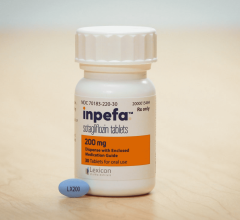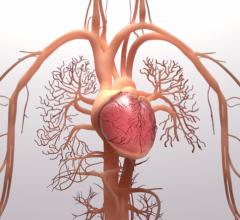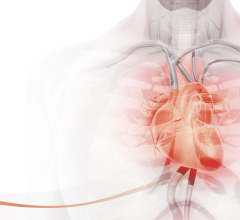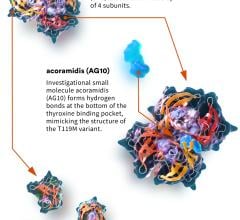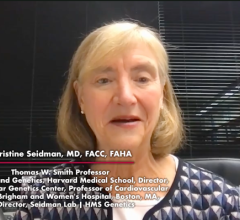March 25, 2013 — The largest randomized study of the vitamin niacin in patients with occlusive arterial disease has shown a significant increase in adverse side effects when it is combined with statin treatment. Results from the HPS2-THRIVE study (Heart Protection Study 2 – Treatment of HDL to Reduce the Incidence of Vascular Events), including the reasons patients stopped the study treatment, were published online in the European Heart Journal.[1]
Niacin has been used for decades to help increase levels of "good" HDL cholesterol and to decrease levels of "bad" LDL cholesterol and triglycerides (fats) in the blood of people at risk of cardiovascular problems such as heart disease and stroke. However, it has a number of side effects, including flushing of the skin. Another drug, laropiprant, can reduce the incidence of flushing by blocking the prostaglandin D2 receptor that is involved in the process. The HPS2-THRIVE study investigated whether combining extended-release niacin with laropiprant (ERN/LRPT), given in addition to an LDL cholesterol-lowering statin, simvastatin, could reduce the risk of cardiovascular problems in people at high risk due to existing occlusive arterial disease.
A total of 25,673 patients from China, the United Kingdom and Scandinavia were randomized between April 2007 and July 2010 to receive either 2 g of extended-release niacin plus 40 mg of laropiprant or matching placebo. In addition, all participants received intensive LDL cholesterol-lowering therapy with simvastatin (with or without ezetimibe). Researchers from the Clinical Trial Service Unit and Epidemiological Studies Unit (CTSU) at the University of Oxford, who were responsible for designing and conducting the trial and analyzing the results, followed the patients for an average of 3.9 years.
By the end of the study, 25 percent of patients taking ERN/LRPT had stopped their treatment, compared with 17 percent of patients taking placebo.
"The main reason for patients stopping the treatment was because of adverse side effects, such as itching, rashes, flushing, indigestion, diarrhea, diabetes and muscle problems. We found that patients allocated to the experimental treatment were four times more likely to stop for skin-related reasons, and twice as likely to stop because of gastrointestinal problems or diabetes-related problems," said Jane Armitage, professor of clinical trials and epidemiology and honorary consultant in public health medicine at the CTSU.
"We found that, in the trial as a whole, participants in the experimental arm had a more-than-four-fold increased risk of myopathy (muscle pain or weakness with evidence of muscle damage) compared with the placebo group," she said. "This is highly significant. It appeared that this effect was about three times greater among participants in China than those in Europe, for reasons that are not clear. In the placebo arm (i.e., those on statin-based treatment alone), the statin-related myopathy was more common among participants in China than those in Europe. Therefore – in combination with the greater effect of ERN/LRPT on myopathy in China – the excess number of cases of myopathy caused by ERN/LRPT (though low in both regions) was over ten times greater among participants in China than those in Europe (0.53 percent per year compared to 0.03 percent per year)."
"This is the largest randomized trial of extended-release niacin treatment, and it provides uniquely reliable results on adverse side effects and the ability of patients to tolerate them," said Richard Haynes, clinical coordinator at the CTSU. "Although 25 percent of patients stopped the treatment early, 75 percent continued on it for approximately four years. Currently, we are analyzing the final data on the cardiovascular outcomes from the trial, and once we have these we will know whether or not the benefits of the treatment outweigh the myopathy, skin and gastrointestinal problems."
The researchers presented full results on the cardiovascular outcomes at the annual meeting of the American College of Cardiology in March.[2]
"Previous research had suggested that improving cholesterol levels in high-risk patients might translate into a 10 to 15 percent reduction in major vascular events such as heart attacks and strokes," said The co-principal investigator of the study, Martin Landray, reader in epidemiology and honorary consultant physician at the CTSU. "In the HPS2-THRIVE study, 3,400 of the 25,673 participants suffered a major vascular event over an average of four years of follow-up. This means the study has excellent statistical power to discover the effectiveness or otherwise of the treatment."
In an accompanying editorial,[3] Ulf Landmesser of the University Hospital Zurich in Switzerland points out that although the study showed an increase in myopathy, it also showed that ERN/LRPT substantially lowered LDL cholesterol and triglycerides by nearly 20 percent. He wrote that the observations "raise important questions as to why niacin/laropiprant did not reduce major cardiovascular events," and he wondered whether laropiprant "is really biologically inert with respect to atherosclerosis and thrombosis."
Landmesser concluded, "Niacin has failed as a valuable 'partner' of statin therapy in lipid-targeted approaches to further reduce major cardiovascular events in high-risk patients. At present, statin therapy has been clearly shown to reduce vascular events effectively and is reasonably well tolerated in most patients. We will still have to wait for the results of … ongoing studies to see whether another lipid-targeted intervention can further reduce vascular events in addition to statin therapy."
For more information: www.thrivestudy.org
References:
[1] "HPS2-THRIVE randomized placebo-controlled trial in 25 673 high-risk patients of ER niacin/laropiprant: trial design, pre-specified muscle, and liver outcomes and reasons for stopping study treatment," by Richard Haynes, Lixin Jiang, Jemma C. Hopewell, Jing Li, Fang Chen, Sarah Parish, Martin J. Landray, Rory Collins and Jane Armitage, The HPS2-THRIVE Collaborative Group. European Heart Journal. doi:10.1093/eurheartj/eht055
[2] In December 2012 the pharmaceutical company Merck, which manufactures ERN/LRPT under the trade name Tredaptive and which funded the HSP2-THRIVE study, issued a statement saying the trial had failed to meet its primary endpoint and that "the combination of extended-release niacin and laropiprant to statin therapy did not significantly further reduce the risk of the combination of coronary deaths, non-fatal heart attacks, strokes or revascularizations compared to statin therapy." ERN/LRPT is not approved for use in the United States, and Merck announced on Jan. 11 that it was taking steps to suspend the availability of Tredaptive (extended-release niacin/laropiprant) tablets worldwide.
[3] "The difficult search for a 'partner' of statins in lipid-targeted prevention of vascular events: the re-emergence and fall of niacin," by Ulf Landmesser. European Heart Journal. doi:10.1093/eurheartj/eht064


 July 10, 2024
July 10, 2024 
